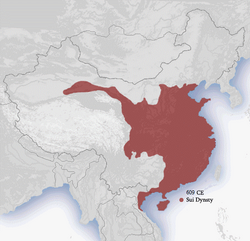Sui Empire
| Sui | ||||||||||||
| 隋 | ||||||||||||
|
||||||||||||
|
Sui dynasty
|
||||||||||||
|
Administrative Division of Sui Dynasty circa 610 AD
|
||||||||||||
| Capital | Daxing (581–605), Luoyang (605–618) | |||||||||||
| Languages | Middle Chinese | |||||||||||
| Religion | Buddhism, Taoism, Confucianism, Chinese folk religion, Zoroastrianism | |||||||||||
| Government | Monarchy | |||||||||||
| Emperor | ||||||||||||
| • | 581–604 | Emperor Wen | ||||||||||
| • | 604–617 | Emperor Yang | ||||||||||
| • | 617–618 | Emperor Gong | ||||||||||
| History | ||||||||||||
| • | Ascension of Yang Jian | 4 March 581 | ||||||||||
| • | Abolished by Li Yuan | 23 May 618 | ||||||||||
| Area | ||||||||||||
| • | 589 est. | 3,000,000 km2 (1,200,000 sq mi) | ||||||||||
| Population | ||||||||||||
| • | 609 est. | est. 46,019,956 | ||||||||||
| Currency | Chinese coin, Chinese cash | |||||||||||
|
||||||||||||
| Today part of |
|
|||||||||||
| Sui dynasty | |||||||||||||||||||||||||||||||||

"Sui dynasty" in Chinese characters
|
|||||||||||||||||||||||||||||||||
| Chinese | 隋朝 | ||||||||||||||||||||||||||||||||
|---|---|---|---|---|---|---|---|---|---|---|---|---|---|---|---|---|---|---|---|---|---|---|---|---|---|---|---|---|---|---|---|---|---|
|
|||||||||||||||||||||||||||||||||
| Transcriptions | |
|---|---|
| Standard Mandarin | |
| Hanyu Pinyin | Suí cháo |
| Gwoyeu Romatzyh | Swei chaur |
| Wade–Giles | Sui2 ch'ao2 |
| IPA | [swěi ʈʂʰǎu] |
| Wu | |
| Romanization | Zoe zau |
| Yue: Cantonese | |
| Yale Romanization | Chèuih chìuh |
| IPA | [tsʰɵ̏y tsʰȉːu] |
| Jyutping | Ceoi4 ciu4 |
| Southern Min | |
| Tâi-lô | Suî-tiâo |
| Middle Chinese | |
| Middle Chinese | dwá ɖjew |
The Sui Dynasty (Chinese: ; pinyin: Suí cháo) was a short-lived imperial dynasty of China of pivotal significance. The Sui unified the Northern and Southern dynasties and reinstalled the rule of ethnic Han Chinese in the entirety of China proper, along with sinicization of former nomadic ethnic minorities (the Five Barbarians) within its territory. It was succeeded by the Tang dynasty, which largely inherited its foundation.
Founded by Emperor Wen of Sui, the Sui dynasty capital was Chang'an (which was renamed Daxing, 581–605) and later Luoyang (605–618). Emperors Wen and Yang undertook various centralized reforms, most notably the equal-field system, intended to reduce economic inequality and improve agricultural productivity; the institution of the Three Departments and Six Ministries system; and the standardization and re-unification of the coinage. They also spread and encouraged Buddhism throughout the empire. By the middle of the dynasty, the newly unified empire entered a golden age of prosperity with vast agricultural surplus that supported rapid population growth.
...
Wikipedia


